The Left Arm of God: Sandy Koufax was more than just a perfect pitcher

In honor of Sports Illustrated's 60th anniversary, SI.com is republishing, in full, 60 of the best stories ever to run in the magazine's history. Today's selection is on Sandy Koufax, whom the magazine named its favorite athlete of the 20th century. Koufax, the youngest person elected into the Baseball Hall of Fame, was the first pitcher to throw four no-hitters and win three Cy Young Awards. The story, by current SI writer Tom Verducci, originally appeared in the July 12, 1999 issue.
He sat in the same booth every time. It was always the one in back, farthest from the door. The trim, darkly handsome man would come alone, without his wife, nearly every morning at six o'clock for breakfast at Dick's Diner in Ellsworth, Maine, about 14 miles from their home. He often wore one of those red-and-black-checkered shirts you expect to see in Maine, though he wasn't a hunter. He might not have shaved that morning. He would walk past the long counter up front, the one with the swivel stools that, good Lord, gave complete strangers license to strike up a conversation. He preferred the clearly delineated no-trespassing zone of a booth. He would rest those famously large hands on the Formica tabletop, one of those mini-jukeboxes to his left and give his order to Annette, the waitress, in a voice as soft and smooth as honey.
He came so often that the family who ran the diner quickly stopped thinking of him as Sandy Koufax, one of the greatest pitchers who ever lived. They thought of him the way Koufax strived all his life to be thought of, as something better even than a famous athlete: He was a regular.
Dick Anderson and his son Richard, better known as Bub, might glance up from their chores when Koufax walked in, but that was usually all. One time Bub got him to autograph a napkin but never talked baseball with him. Annette, Bub's sister, always worked the section with that back booth. For three years Koufax came to the diner and not once did he volunteer information to her about his life or his career. It was always polite small talk. Neighborly. Regular.
Koufax was 35, five years since his last pitch, in 1966, when he came eagerly, even dreamily, to Maine, the back booth of America. He had seen a photo spread in Look magazine about the Down East country homestead of a man named Blakely Babcock, a 350-pound Burpee Seed salesman, gentleman farmer and gadfly whom everybody called Tiny. Tiny would invite neighbors and friends over for cookouts and dinner parties, during which he liked to consume great quantities of food, then rub his huge belly and bellow laughingly to his wife, "So, what's for dinner, Alberta?" Tiny's North Ellsworth farmhouse caught Koufax's fancy at just about the same time one of his wife's friends was renovating her farmhouse in Maine. Wouldn't it be perfect, Koufax thought, to live quietly, almost anonymously, in an old farmhouse just like Tiny's?
Alberta Babcock was pulling a hot tin of sweet-smelling blueberry muffins from the oven when Koufax first saw the place in person, and the old Cape-style house was filled with so many flowers that it looked like a watercolor come to life. Koufax was sold, and on Oct. 4, 1971, Sanford and Anne Koufax of Los Angeles, as they signed the deed, took out a 15-year, $15,000 mortgage from Penobscot Savings Bank and bought what was known as Winkumpaugh Farm from Blakely and Alberta Babcock for about $30,000. A cord was cut. The rest of Sandy Koufax's life had begun.
The Babcocks had lived in the farmhouse since 1962, but no one was exactly sure how old the place was. Property records were lost to a fire at Ellsworth City Hall in 1933, and records from 1944 list the farmhouse's age even then only as "old." Nestled on the side of a small mountain off a dusty dirt road called Happytown Road and around the corner from another called Winkumpaugh Road, the farmhouse was the perfect setting for a man hoping to drop out of sight, even if that man was a beloved American icon who mastered the art of pitching as well as anyone who ever threw a baseball.
SI 60 Q&A: Tom Verducci on Sandy Koufax and 'The Left Arm Of God'
A man so fiercely modest and private that while at the University of Cincinnati on a basketball scholarship, he didn't tell his parents back in Brooklyn that he was also on the baseball team. The man whose mother requested one of the first copies of his 1966 autobiography, Koufax, so she could find out something about her son. ("You never told me anything," she said to him.) The man who in 1968, two years after retiring with three Cy Young Awards, four no-hitters and five ERA titles, mentioned nothing of his baseball career upon meeting a pretty young woman named Anne who was redecorating her parents' Malibu beach house. Koufax did offer to help her paint, though. It wasn't until several days later that she learned his identity -- and he learned hers: She was the daughter of actor Richard Widmark. They were married six months later in her father's West Los Angeles home in front of about a dozen people.
The last two years that Anne and Sandy Koufax lived at Winkumpaugh Farm were the first in his life when he was bound by neither school nor work. After commuting from Maine during the summer of 1972 for his sixth season as a television commentator for NBC, he quit with four years left on his contract. He loathed the work. He could tell you every pitch thrown by every pitcher in a game without having written anything down, but there was a problem: He didn't like to talk about himself. At a meeting before Game 5 of the 1970 World Series, fellow announcer Joe Garagiola noted that Cincinnati's starting pitcher, Jim Merritt, had an injured arm. "I said, 'Sandy, what a perfect thing to talk about. That's what you had, too.'" Garagiola says. "But he said he didn't want to talk about himself. He wouldn't do it."
"Every time he had to leave Maine to work one of those games, it broke his heart," says MaJo Keleshian, a friend and former neighbor who attended Sarah Lawrence College with Anne. She still lives without a television on land she and her husband bought from Koufax. "He was very happy here. He came here to be left alone."
Since then only his address has changed -- and many times, at that. DiMaggio, baseball's other legendary protector of privacy, was practically Rodmanesque compared with Koufax. DiMaggio was regal, having acquired even the stiff-handed wave of royalty. We watched the graying of DiMaggio as he played TV pitchman and public icon. Koufax is a living James Dean, the aura of his youth frozen in time; he has grayed without our even knowing it. He is a sphinx, except that he doesn't want anyone to try to solve his riddle.
Koufax was the kind of man boys idolized, men envied, women swooned over and rabbis thanked, especially when he refused to pitch Game 1 of the 1965 World Series because it fell on Yom Kippur. And when he was suddenly, tragically, done with baseball, he slipped into a life nearly monastic in its privacy.
One question comes to mind: Why? Why did he turn his back on Fame and Fortune, the twin sirens of celebrity? Why did the most beloved athlete of his time carve out a quiet life -- the very antithesis of the American dream at the close of the century? For the answer I will go searching for the soul of Sandy Koufax, which seems as mysterious as the deepest Maine woods on a moonless night.
Bob Ballard is a retiree in Vero Beach, Fla., who works part time as a security guard at Dodgertown, the sleepiest spring training site in all of baseball. Sometime around 1987 he told the secretary who worked for Peter O'Malley, then the owner of the Dodgers, how much he would enjoy getting an autograph from Koufax for his birthday. A few days later Koufax, working for the Dodgers as a roving pitching instructor, handed Ballard an autographed ball and said, "Happy birthday."
Every year since then, on or about Ballard's birthday, Koufax has brought the old man an autographed ball. Koufax delivered on schedule this year for Ballard's 79th birthday. "He's a super, super guy," says Ballard. "Very courteous. A real gentleman. A lot nicer than these players today."
***
It is a lovely day for golf. I am standing in the tiny pro shop of the Bucksport (Maine) Golf Club, a rustic, nine-hole track. The parking lot is gravel. Even the rates are quaint: $15 to play nine holes, $22 for 18, and you are instructed to play the white tees as the front nine, then the blue tees as the back nine. There is no valet parking, no tiny pyramids of Titleists on the scrubby range, no MEMBERS ONLY signs, no attitude. This is Koufax's kind of place. I am standing in the imprint of his golf spikes, a quarter-century removed. He was a member of the Bucksport Golf Club, one of its more enthusiastic members.
It wasn't enough that he play golf, he wanted to be good enough to win amateur tournaments. Koufax was working on the engine of a tractor one day when a thought came to him about a certain kind of grip for a golf club. He dropped his tools, dashed into his machine shop, fiddled with a club and then raced off to the Bucksport range. He was still wearing dungaree shorts and a grease-splattered shirt when he arrived. "That's how dedicated to the game he was," says Gene Bowden, one of his old playing partners.
Koufax diligently whittled his handicap to a six and entered the 1973 Maine State Amateur. He advanced to the championship flights by draining a 30-foot putt on the 18th hole. He missed the next cut, though, losing on the last hole of a playoff.
Koufax is exacting in every pursuit. Ron Fairly, one of his Dodgers roommates, would watch with exasperation as Koufax, dressed suavely for dinner in glossy alligator shoes, crisply pressed slacks and a fruit-colored alpaca sweater, would fuss over each hair in his sideburns. "Reservation's in 15 minutes, and it's a 20-minute ride," Fairly would announce, and Koufax would go right on trimming until his sideburns were in perfect alignment.
The Mourning Anchor: Bryant Gumbel is alone at the top with the memory of his late father
He brought that same meticulousness to Maine. It wasn't enough to dabble in carpentry and home electronics -- he built and installed a sound system throughout the house. It wasn't enough to cook -- he became a gourmet cook, whipping up dishes not by following recipes but by substituting ingredients and improvising by feel. Later in life it wasn't enough to jog; he ran a marathon. He didn't just take up fishing, he moved to Idaho for some of the best salmon fishing in the world. He defines himself by the fullness of his life and the excellence he seeks in every corner of it, not the way the rest of the word defines him: through the narrow prism of his career as a pitcher. "I think he pitched for the excellence of it," Keleshian says. "He didn't set out to beat someone or make anyone look bad. He used himself as his only measure of excellence. And he was that way in everything he did. He was a fabulous cook, but he was almost never quite satisfied. He'd say, Ah, it needs a little salt or a little oregano, or something. Once in a great while he'd say, Ah-ha! That's it!"
Walt Disney, John Wayne, Kirk Douglas, Daryl Zanuck and all the other Hollywood stars who held Dodgers season tickets when Koufax was the biggest star in America never came to Winkumpaugh Farm. The fans never came, either, though a fat sack of fan mail arrived every week, even seven years after he last threw a pitch. The place was perfect, all right. He could move about without fuss, without having to talk about his least favorite subject: himself. "He did say once that he'd rather not talk baseball and his career," Bowden says. "And we never did."
"When Hideo Nomo was getting really, really big, Sandy told me, 'He'd better learn to like room service,'" O'Malley says. "That's how Sandy handled the attention." Koufax almost never left his hotel room in his final two seasons for the Dodgers. It wasn't enough that he move to a creaky, charmingly flawed farmhouse in Maine with a leaky basement, he quickly bought up almost 300 acres adjacent to it.
Not even the serenity of Maine, though, could quell Koufax's wanderlust. After three years he decided the winters were too long and too cold. The farmhouse needed constant work. His stepfather took ill in California. Koufax sold Winkumpaugh Farm on July 22, 1974, leaving for the warmer but still rural setting of Templeton, Calif., in San Luis Obispo County.
Koufax is 63, in terrific shape and, thanks to shoulder surgery a few years back, probably still able to get hitters out. (In his 50s Koufax was pitching in a fantasy camp when a camper scoffed after one of his pitches, "Is that all you've got?" Koufax's lips tightened and his eyes narrowed -- just about all the emotion he would ever show on the mound -- and he unleashed a heater that flew damn near 90 mph.)
The romance with Anne ended with a divorce in the early '80s. He remarried a few years later, this time to a fitness enthusiast who, like Anne, had a passion for the arts. That marriage ended in divorce last winter. Friends say Koufax is delighted to be on his own again. Says Lou Johnson, a former Dodgers teammate, "He has an inner peace that's really deep-rooted. I wish I had that."
He is the child of a broken marriage who rejected everything associated with his father, including his name. Sanford Braun was three years old when Jack and Evelyn Braun divorced, and his contact with Jack all but ended about six years later when Jack remarried and stopped sending alimony payments. Evelyn, an accountant, married Irving Koufax, an attorney, a short time later. "When I speak of my father," he wrote in his autobiography, "I speak of Irving Koufax, for he has been to me everything a father could be." Koufax rarely spoke to Jack Braun, and not at all during his playing days. When the Dodgers played at Shea Stadium, Jack would sit a few rows behind the visitors' dugout and cheer for the son who neither knew nor cared that he was there.
Now there is but one Koufax bearing that name. He has no children, no immediate family -- both his mother and stepfather are deceased. The death of his only sibling, a sister, in 1997, had a profound impact on a man who has struggled to deal with the deaths of friends and other players from his era. "People react to death differently," O'Malley says. "Sandy takes a death very, very, very hard."
He has a small circle of close friends, and many other buddies who always seem to be one or two phone numbers behind him. "It sounds odd, but he's very home-oriented," Keleshian says, "yet very nomadic."
His list of home addresses since he stopped playing baseball reads like a KOA campground directory: North Ellsworth, Maine; Templeton and Santa Barbara, Calif.; Idaho; Oregon (where his second wife ran a gallery); North Carolina (where he and his second wife kept horses); and Vero Beach -- not to mention extensive trips to Hawaii, New Zealand and Europe. This spring he was looking for a new place to spend the summer and once again had his eye on rural New England. "He doesn't say much about what he's up to," says Bobby McCarthy, a friend who owns a Vero Beach restaurant that Koufax prefers to frequent when it's closed. "We'll be sitting in the restaurant in the morning, and that night I'll see he's at a Mets game in New York. And he hadn't said anything that morning about going there. But that's Sandy."
***
At 8:30 on a lovely Sunday morning in March, I attend a chapel service in the Sandy Koufax Room at Dodgertown. Players and coaches in their fabulously white Dodgers uniforms are there, but not Koufax. The Dodgers give glory to Jesus Christ every Sunday in a conference room named for the greatest Jewish ballplayer who ever lived. Outside the room is a picture of a young Koufax, smiling, as if he is in on the joke.
Don Sutton is a native of Clio, Ala., who reached the big leagues at age 21 in 1966, which is to say he got there just in time. His first season in the majors was Koufax's last. Says Sutton, "I saw how he dressed, how he tipped, how he carried himself and knew that's how a big leaguer was supposed to act. He was a star who didn't feel he was a star. That's a gift not many people have."
Tommy Hutton, who grew up in Los Angeles, also made his big league debut for the Dodgers in '66, entering the ninth inning at first base as Koufax finished off the Pirates 5-1 on Sept. 16. Says Hutton, now a broadcaster for the Marlins, "I'll never forget this. After the game he came up to me and said, 'Congratulations.' Ever since then, I've always made it a point to congratulate a guy when he gets into his first game."
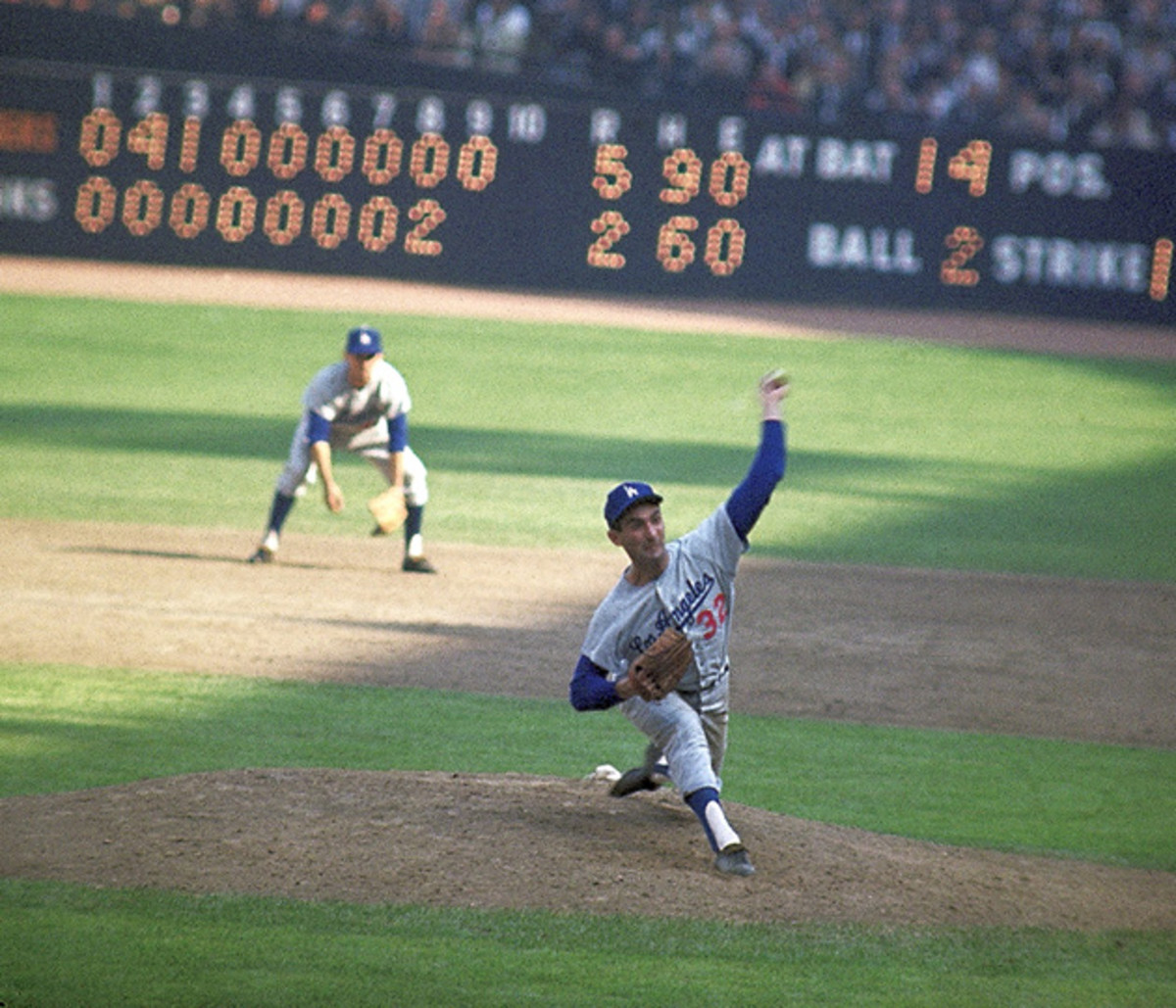
. When the program ends, Sutton and all his guests -- former Dodgers Ron Cey and Steve Garvey among them -- march past me toward an elevator that will take them to a stadium suite. All except Koufax. He is gone. Vanished. I find out later that as soon as the ceremony was over, he arose from his chair, walked briskly into the Dodgers dugout and kept right on going into the team parking lot and off into the night. "That's Sandy," said one team official. "We call him the Ghost."
I am searching for an apparition. I never saw Koufax pitch, never felt the spell he held over America. I had just turned six when Koufax walked into the Sansui room of the Regent Beverly Wilshire Hotel on Nov. 18, 1966, to announce his retirement from baseball. To have missed his brilliance heightens the fascination. For me he is black-and-white newsreel footage shot from high behind home plate, and an inexhaustible supply of statistics that border on the absurd. A favorite: Every time he took the mound, Koufax was twice as likely to throw a shutout as he was to hit a batter.
Koufax was 30 years old when he quit. Women at the press conference cried. Reporters applauded him, then lined up for his autograph. The world, including his teammates, was shocked. In the last 26 days of his career, including a loss in the 1966 World Series, Koufax started seven times, threw five complete-game wins and had a 1.07 ERA. He clinched the pennant for Los Angeles for the second straight year with a complete game on two days rest. Everyone knew he was pitching with traumatic arthritis in his left elbow, but how bad could it be when he pitched like that?
It was this bad: Koufax couldn't straighten his left arm -- it was curved like a parenthesis. He had to have a tailor shorten the left sleeve on all his coats. Use of his left arm was severely limited when he wasn't pitching. On bad days he'd have to bend his neck to get his face closer to his left hand so that he could shave. And on the worst days he had to shave with his right hand. He still held his fork in his left hand, but sometimes he had to bend closer to the plate to get the food into his mouth.
His elbow was shot full of cortisone several times a season. His stomach was always queasy from the cocktail of anti-inflammatories he swallowed before and after games, which he once said made him "half-high on the mound." He soaked his elbow in an ice bath for 30 minutes after each game, his arm encased in an inner tube to protect against frostbite. And even then his arm would swell an inch. He couldn't go on like this, not when his doctors could not rule out the possibility that he was risking permanent damage to his arm.

to meet him in a room off the Dodgers' clubhouse. Koufax and Collier often sat next to each other on the team's charter flights, yapping about politics, the economy or literature. "Next year's going to be my last year," Koufax told Collier. "The damn thing's all swelled up. And I hate taking the pills. They slow my reactions. I'm afraid someone's going to hit a line drive that hits me in the head."
Koufax didn't tell anyone else, and he made Collier promise not to write the story. So they shared that little secret throughout the 1966 season. When the Dodgers went to Atlanta, Collier whispered to Koufax, "Last time here for you." And that is exactly how Koufax pitched that season, as if he would never pass this way again. He won a career-high 27 games, pushing his record in his final six seasons to 129-47. He was 11-3 in his career in 1-0 games. In 1965 and '66 he was 53-17 for the club that scored fewer runs than all but two National League teams.
"He's the greatest pitcher I ever saw," says Hall of Famer Ernie Banks. "I can still see that big curveball. It had a great arc on it, and he never bounced it in the dirt. Sandy's curve had a lot more spin than anybody else's -- it spun like a fastball coming out of his hand -- and he had the fastball of a pure strikeout pitcher. It jumped up at the end. The batter would swing half a foot under it. Most of the time we knew what was coming, because he held his hands closer to his head when he threw a curveball, but it didn't matter. Even though he was tipping off his pitches, you still couldn't hit him."
Koufax was so good, he once taped a postgame radio show with Vin Scully before the game. He was so good, the relief pitchers treated the night before his starts the way a sailor treats shore leave. On one rare occasion in which Koufax struggled to go his usual nine innings -- he averaged 7.64 per start from '61 to '66 -- manager Walter Alston visited his pitcher while a hungover Bob Miller warmed in the bullpen.
"How do you feel, Sandy?" Alston asked.
"I'll be honest with you, Skip," Koufax said. "I feel a hell of a lot better than the guy you've got warming up."
On Nov. 17, 1966, Collier came home from watching the Ice Capades and was greeted with this message from his babysitter: "Mr. Koufax has been trying to call you for a couple of hours." Collier knew exactly what it was about. He called Koufax.
"I'm calling the wire services in the morning," Koufax told him. "Is there anything you need from me now?"
"Sandy," Collier said, "I wrote that story months ago. It's in my desk drawer. All I have to do is make a call and tell them to run it."
Says Collier, "It was the biggest story I'll ever write. They ran it across the top of Page One with a big headline like it was the end of World War II."

I have gotten ahold of Koufax's home telephone number in Vero Beach, but I do not dare dial it. Even from afar I can feel the strength of this force field he has put around himself. To puncture it with a surprise phone call means certain disaster. I have read that Koufax so hated the intrusions of the telephone during his playing days that he once took to stashing it in his oven. Buzzie Bavasi, the Dodgers' general manager, would have to send telegrams to his house saying, "Please call."
I don't call. I am an archeologist -- dig I must, but with the delicate touch of brushes and hand tools. I enlist the help of Koufax's friends. Now I understand why people I talk to about Koufax are apprehensive. They ask, Does Sandy know you're doing this story? (Yes.) It's as if speaking about him is itself a violation of his code of honor.
There is a 58-year-old health-care worker in Portchester, N.Y., named David Saks who attended Camp Chi-Wan-Da in Kingston, N.Y., in the summer of 1954. Koufax, who is from Brooklyn, was his counselor. "He was this handsome, strapping guy, a great athlete who had professional scouts trying to sign him," Saks says. "I was 13. He was 18. We all were in awe of him. But even then there were signs that he wanted people to avoid fussing about him to the nth degree."
Saks needed a day to think before agreeing to share two photographs he has from Camp Chi-Wan-Da that include the teenage Koufax. "Knowing how he is ... ," Saks explains. Saks has neither seen nor spoken to Koufax in 45 years. He does, however, have recurring dreams about happy reunions with him.
In Vero Beach, where Koufax spends much of his time now, the townsfolk choose not to speak his name when they come upon him in public. They will say, "Hello, Mr. K.," when they run into him at the post office or, "Hello, my good friend," rather than tip off a tourist and risk creating one of those moments Koufax detests.
"Sandy has a quiet, productive way about him," says Garagiola, president of the Baseball Assistance Team (BAT), a charity that helps former players in medical or financial straits. Garagiola sometimes calls Koufax to ask him to speak with former players who are particularly hurting. "He can't really understand that," Garagiola says. "He's got a great streak of modesty. He'll say, 'What do they want to talk to me for?' He is a Hall of Famer in every way. He'll make an impact. You won't know it and I won't know it, but the guy he's helping will know it. Above anything else, I'll remember him for his feelings for fellow players."
There was an outfielder named Jim Barbieri who joined the Dodgers during the 1966 pennant race. He was so nervous that he would talk to himself in the shower, and the pressure so knotted his stomach that he once threw up in the locker room. One day Koufax motioned toward Barbieri in the dugout and said to Fairly, "I have a responsibility to guys like him. If I pitch well from here on out, I can double that man's income." Koufax, who was referring to World Series bonus money, went 8-2 the rest of the season. From 1963 to '66 he was 14-2 in September, with a 1.55 ERA.
Earlier in that 1966 season a television network offered Koufax $25,000 to allow their cameras to trail him on and off the field. Koufax said he would do it for $35,000, and only if that money was divided so that every Dodgers player, coach and trainer received $1,000.
Koufax attends Garagiola's BAT dinner in New York City every winter, and always draws the biggest crowd among the many Hall of Famers who sign autographs during the cocktail hour. "I grew up in Brooklyn," says Lester Marks of Ernst and Young, which secured the Koufax table this year. "I went to Ebbets Field all the time. I'm 52. I thought seeing Sandy Koufax pitch was the thrill of a lifetime, but meeting him as an adult was an even bigger thrill. My guests were shocked at what a down-to-earth gentleman he is."
After this year's dinner I walked through the crowded ballroom toward Koufax's table, only to see him hustle to a secured area on the dais. He posed for pictures with the Toms River, N.J., Little League world champions. Then he was gone, this time for a night of refreshments in Manhattan with New York Mets pitcher Al Leiter, as close to a protege as Koufax has in baseball.
I should mention that I did meet Sandy Koufax a few years ago, before I embarked on this quest to find out what makes him run. I was at Dodgertown, standing next to the row of six pitching mounds adjacent to the Dodgers' clubhouse. "Sacred ground," as former Dodgers pitcher Claude Osteen calls it, seeing as it was here that Branch Rickey hung his famous strings, forming the borders of a strike zone at which every Dodgers pitcher from Newcombe to Koufax to Sutton to Hershiser took aim. (Koufax was so wild as a rookie that pitching coach Joe Becker took him to a mound behind the clubhouse so he would not embarrass himself in front of teammates and fans.)
The Importance Of Being Barry: The best player in baseball? Barry Bonds. (Just ask him.)
Tan and lean, Koufax looked as if he had just come in from the boardwalk to watch the Los Angeles pitchers throw. He was dressed in sandals, a short pair of shorts and a polo shirt. I said something to him about the extinction of the high strike. Koufax said that he hadn't needed to have that pitch called a strike in order to get batters to swing at his high heater. When I followed up with a question about whether baseball should enforce the high strike in today's strike zone, Koufax's face tightened. I could almost hear the alarms sounding in his head, his warning system announcing, This is an interview! He smiled in a polite but pained way and said in almost a whisper, "I'd rather not," and walked away.
When chatty reporters aren't around, that lonely pedestal called a pitching mound still gives Koufax great pleasure. He is the James Bond of pitching coaches. His work is quick, clean, stylish in its understatement and usually done in top-secret fashion. He has tutored Cleveland's Dwight Gooden and L.A.'s Chan Ho Park on their curveballs and Houston's Mike Hampton on his confidence; convinced L.A.'s Kevin Brown that it was O.K. to lead his delivery with his butt; and taught former Dodger Orel Hershiser to push off the rubber with the ball of his foot on the dirt and the heel of his foot on the rubber. Hershiser removed some spikes from the back of his right shoe so that he could be more comfortable with Koufax's style of pushing off.
Koufax has tried since 1982 to teach his curveball technique to Mets closer John Franco. "I can't do it," Franco says. "My fingers aren't big enough to get that kind of snap." Koufax was God's template for a pitcher: a prizefighter's back muscles for strength, long arms for leverage and long fingers for extra spin on his fastball and curveball. The baseball was as low as the top of his left ankle when he reached back to throw in that last calm moment of his delivery -- like a freight train cresting a hill -- just before he flung the weight and force of his body toward the plate.
His overhand curveball was vicious because his long fingers allowed him to spin the ball faster than anybody else. Most pitchers use their thumb to generate spin, pushing with it from the bottom of the ball and up the back side. Koufax could place his thumb on the top of the ball, as a guide -- similar to the way a basketball player shooting a jumper uses his off-hand on the side of the ball -- because his long fingers did all the work, pulling down on the baseball with a wicked snap. On the days he wasn't pitching Koufax liked to hold a ball with his fastball and curveball grips because he believed it would strengthen the muscles and tendons in his left hand by just the tiniest bit.
Koufax may be the best pitching coach alive, though he wants no part of that job's high visibility or demands on his time. He cannot be pinned down any easier than a tuft of a dandelion blown free by the wind. After quitting NBC in February 1973, Koufax didn't take another job until 1979, when he explained that his return to the Dodgers as a roving minor league pitching coach was partly due to financial concerns. Koufax pitched 12 years in the majors and made only $430,500 in salary. He has steadfastly rejected endorsement offers and supplements his income with perhaps two card shows a year.
In the '80s Koufax enjoyed staying under the big league radar by doing his coaching for the Dodgers at the minor league level, in places such as San Antonio, Albuquerque and Great Falls, Mont., where he liked to stay up late talking pitching with the players and staff. He likes helping young players. In Great Falls he saw the potential of a righthander the organization was down on for being too hot-tempered. "He's got the best arm on the staff," Koufax said. "Stay with this guy." He was right about John Wetteland, the Texas Rangers' closer, now in his 11th season as one of the most reliable short relievers in baseball.

Koufax abruptly quit the Dodgers in February 1990. O'Malley had thought he was doing Koufax a favor by ordering the farm director to cut back on Koufax's assignments in 1989, but Koufax told O'Malley, "I just don't think I'm earning what you're paying me." He also was ticked off when one of the Dodgers bean counters bounced back an expense report to him over a trivial matter. Since then Koufax has worked on an ad hoc basis, ready to help his friends.
Fox baseball analyst Kevin Kennedy, who carries a handwritten note from Koufax in his wallet, invited him to spring training in 1993 when Kennedy was managing the Texas Rangers. Koufax stayed one week, insisting that he wear an unmarked jersey with a plain blue cap rather than the team's official uniform. "He really enjoyed it," says Osteen, who was Kennedy's pitching coach. "Every night we'd go out to dinner and just talk baseball deep into the night. At the end of the week he said, 'You know, I've really had a good time.' I was floored. For him to acknowledge how he felt was a major, major thing. Believe me. I could tell he had missed the game. But at the same time, after a week of it he was ready to go back to his own private life. One week was enough."
Last year Koufax visited the Mets' camp in Port St. Lucie, Fla., as a favor to owner Fred Wilpon, a former teammate at Lafayette High School in Brooklyn, and Dave Wallace, the Mets' pitching coach who befriended Koufax when Wallace was working in the Dodgers' minor league system. Koufax sat in front of the row of lockers assigned to the Mets' pitchers and began talking. A crowd grew, pulling into a tight circle like Boy Scouts around a campfire. Koufax looked at Leiter -- also a lefthander -- and said, "Al, you've had a nice career. Pitched in the World Series. But you can be better."
"I know," Leiter said. "Can you help me?"
Koufax liked that. He showed Leiter how he used to push off the rubber. He asked Leiter about where he aimed a certain pitch, and when Leiter said, "I'm thinking outer half --" Koufax cut him off. "Stop!" he said. "You never think outer half. You think a spot on the outside corner. Think about throwing the ball through the back corner of the plate, not to it."
What Koufax stressed most was that Leiter needed to pitch away more to righthanded hitters. Koufax lived on fastballs on the outside corner. Leiter, who says that many hitters today dive into the ball, prefers to pound cut fastballs on their fists. But Koufax showed Leiter how to make the ball run away from righthanders by changing the landing spot of his right foot by one inch and by letting his fingers come off slightly to the inside half of the ball. And Koufax shared the lesson that saved his career, the lesson it took him six years in the big leagues to learn: A fastball will behave better, with just as much life and better control, if you throttle back a little. "Taking the grunt out of it," is how Koufax put it.
In 1961 Koufax was a career 36-40 pitcher with awful control problems. He was scheduled to throw five innings in the Dodgers spring training B game against the Twins in Orlando, but the other pitcher missed the flight, and Koufax said he'd try to go seven. His catcher and roommate, Norm Sherry, urged him to ease up slightly on his fastball, throw his curve and hit his spots. Koufax had nothing to lose; manager Walter Alston and the front office were at the A game. Cue the chorus of angels and dramatic lighting. Koufax got it. He threw seven no-hit innings and, as he wrote in his book, "I came home a different pitcher from the one who had left."
A few weeks after Koufax spoke to the Mets' staff, an excited Wilpon approached Leiter in the clubhouse and said, "I don't know what you did with Sandy, but he wants you to have his home number. I've never known him to do this before with any player. If you ever want to talk with him, just give him a call."
Leiter says he rang the dial-a-legend line three or four times. "I wasn't sure what to do," he says. "I didn't want to call so much where he would think I was taking advantage of our friendship. On the other hand, I didn't want to not call, and he'd think, 'That guy is blowing me off.' It's kind of delicate, you know what I mean? But Sandy's cool. Real cool." At 32, Leiter had the best season of his career (17-6, 2.47). "I accepted the idea of throwing outside more," he says. "The times when I did it fairly often were the three or four most dominating games I had all year."
Koufax likes to slip into Dodgertown during spring training unnoticed, parking his Saab convertible or his Jeep Wagoneer in a back lot, visiting with O'Malley if he sees the shades open to Villa 162 and watching pitchers throw on the sacred ground of the practice mounds. He has noticed that there are a lot more microphones and cameras at Dodgertown since Rupert Murdoch bought the team last year. He is not happy about that.
I am chatting with Bobby McCarthy, Koufax's friend from Vero Beach, during an exhibition game at Dodgertown when Dave Stewart, a former Koufax pupil (who himself coached the pennant-winning San Diego Padres pitching staff last year), stops by. "We were talking about Sandy," McCarthy says.
"Oh, yeah?" Stewart says. "I just saw him in the clubhouse."
I bolt, but when I get to the clubhouse, the Ghost has vanished. I can practically smell the ethereal contrails.
A few days later I get the official word from a member of Koufax's inner circle: "He doesn't want to talk. He's at the point where he doesn't care what people write; he just doesn't
want to say anything. Sorry."
I fire my last bullet. The home phone number. I haven't needed to muster this kind of courage to dial a telephone since I asked my date to our high school prom. The phone rings. I remember the code: The answering machine is on if he's in town, off if he's not. The phone just keeps ringing.

It is Opening Day of the 1999 season. I am standing before the house at Winkumpaugh Farm. Or what is left of it. It burned to the ground 22 days ago.
I am staring at a cement hole in the ground filled with ash and garbage and the stump of a chimney. Standing with me is Dean Harrison, a 45-year-old intensive-care nurse who grew up in West Orange, N.J., rooting for Koufax. He bought the property last year and lives in a house farther up the hill. When his power goes out during a winter storm, he calls the utility company and says, "The Koufax line is out." And they know exactly where the problem is. He knows the history of the place.
Koufax sold Winkumpaugh Farm to Herbert Haynes of Winn, Maine, who sold it three months later to John and Kay Cox of Mare Island, Calif. Cox was an absentee landlord, renting it when he could. Young people used it as a party house. Necessary repairs were left undone. By the time Henderson bought it last fall, Winkumpaugh Farm was in awful shape. "I wanted to save it," he says. "I was about 30 years too late." He finally decided to donate the farmhouse to the Ellsworth Fire Department.
The Ring Leader: Bill Russell helped the Celtics rule their sport like no team ever has
When the fire company went out to the house on March 14, patches of ground were showing through what was left of winter's last snowfall. The first thing the firemen did was grab pieces of Sandy Koufax's life for themselves. They pulled up floorboards and planks of clapboard siding. A policeman, Tommy Jordan, tossed some switch plates, two faucet handles and a small pile of bricks into the back of his squad car.
After this bit of scavenging, the firefighters practiced a few rescues with a controlled fire, then they scattered hay on Winkumpaugh Farm's old wood floors and torched it. The old place went up quick as kindling, gone before a tear could fall to the snow.
After the fire burned out, Keleshian reached into the smoldering ruin and took some ancient square-headed nails. She also took some of the farmhouse's charcoaled remains, with which she plans to sketch from memory two drawings of Winkumpaugh Farm -- one for Anne and one for Sandy.
The early spring sun holds me in its warmth as it begins to sink behind the mountain beyond the valley. The quiet of North Ellsworth is profound, disturbed only by the gentle whisper of the wind through the pines and the bare branches of the oak, beech, birch and apple trees.
The farmhouse is gone, and yet I see it clearly. I see the weather vane atop the tiny cupola, the second-floor dormers, the screened-in porch and the white sign under the eaves that says WINKUMPAUGH FARM in black letters. I can hear classical music playing through homemade speakers. I can smell dinner wafting through the cozy house. Without the recipe in front of him, Sandy is making his grandmother's stuffed cabbage. He is surrounded by friends, laughter, the glow of a wood-burning stove and the warmth of walls lined with hardbound books. He is home.
Koufax always hated it when people described him as a recluse, and I have come to understand how wrong that label is. A recluse doesn't touch so many people with lifelong lessons of generosity, humility and the Zen of the curveball.
I have rebuilt his farmhouse in my mind, and it is sturdier and more beautiful this way. Why shouldn't I do the same when taking the measure of the man who once lived there? Must every blank be filled in, leaving us no room to construct parts of him as we wish? What we don't see can help us keep him forever young, unflinchingly true to himself, forever an inspiration.
Looking at the ruins of Winkumpaugh Farm at my feet, I realize that I no longer need that Vero Beach phone number. I have found Sandy Koufax.
GALLERY: Classic SI photos of Sandy Koufax
Classic SI Photos of Sandy Koufax
Sandy Koufax
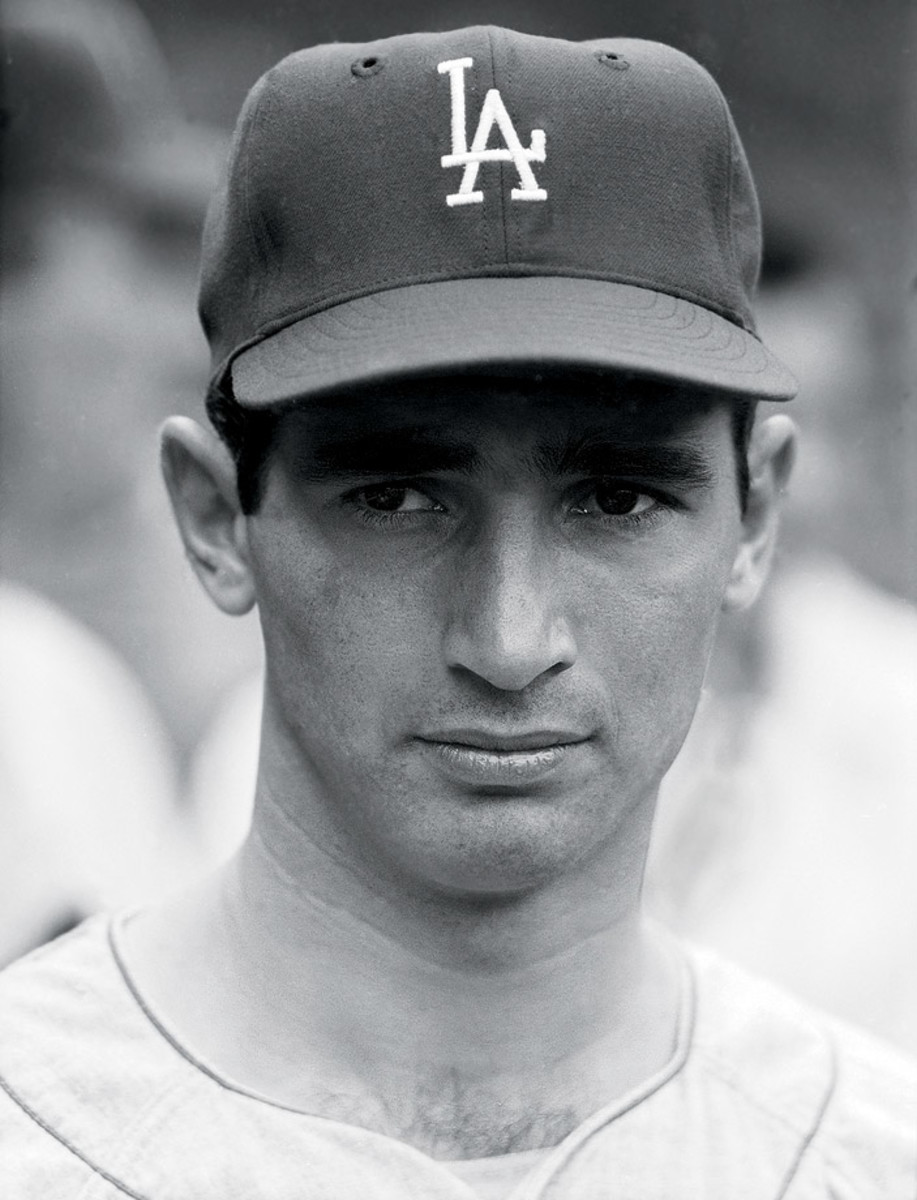
1959 World Series
Sandy Koufax
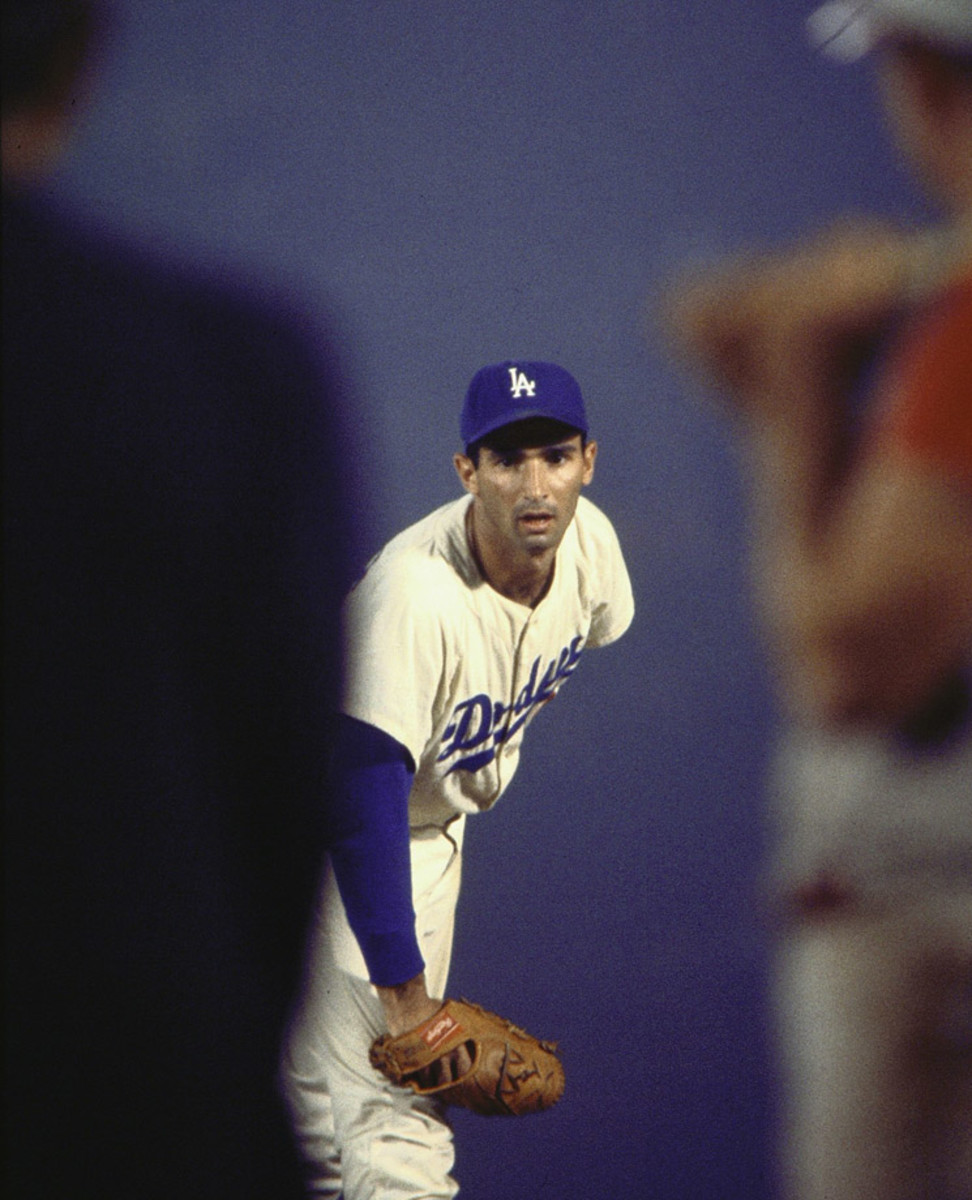
Aug. 16, 1961
Sandy Koufax

Aug. 27, 1961
Don Drysdale and Sandy Koufax
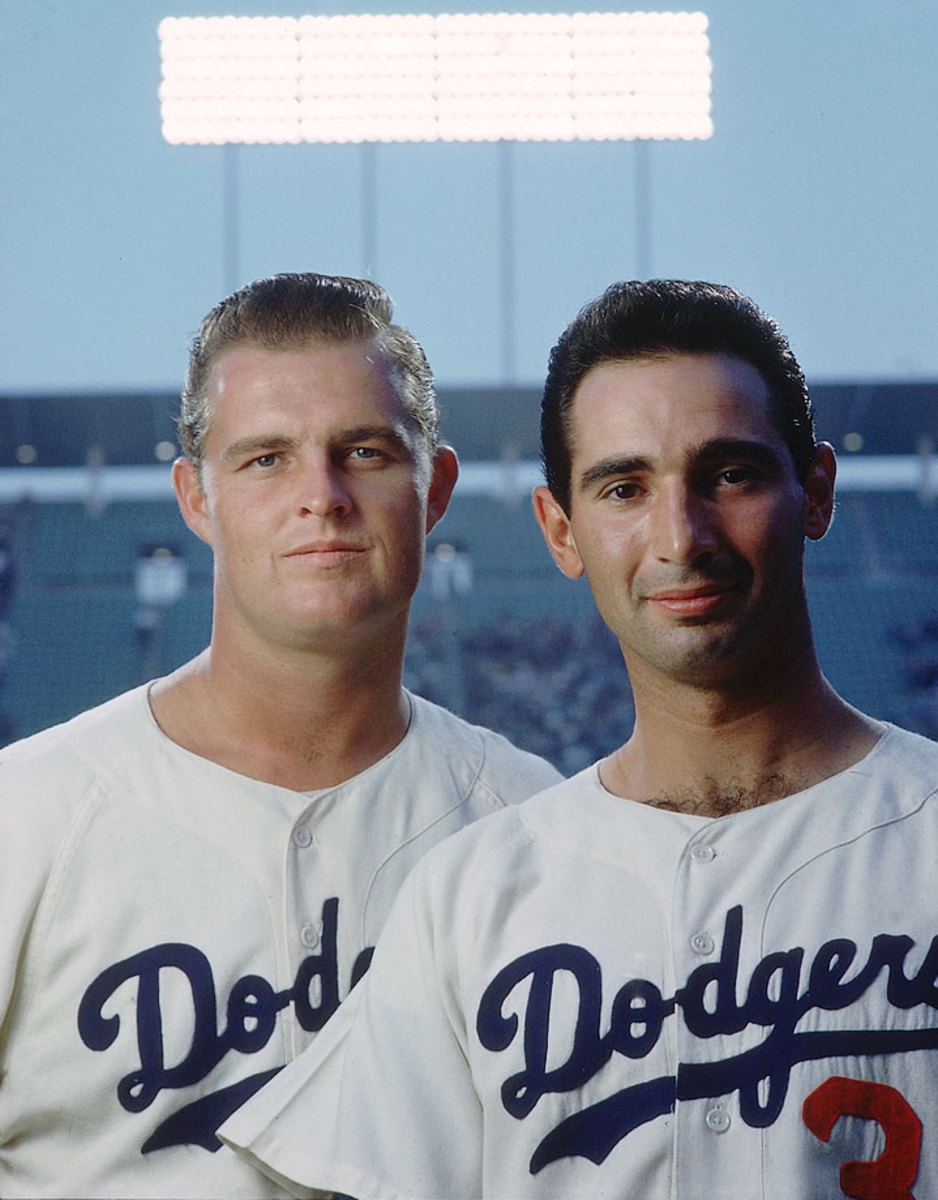
June 26, 1962
Sandy Koufax
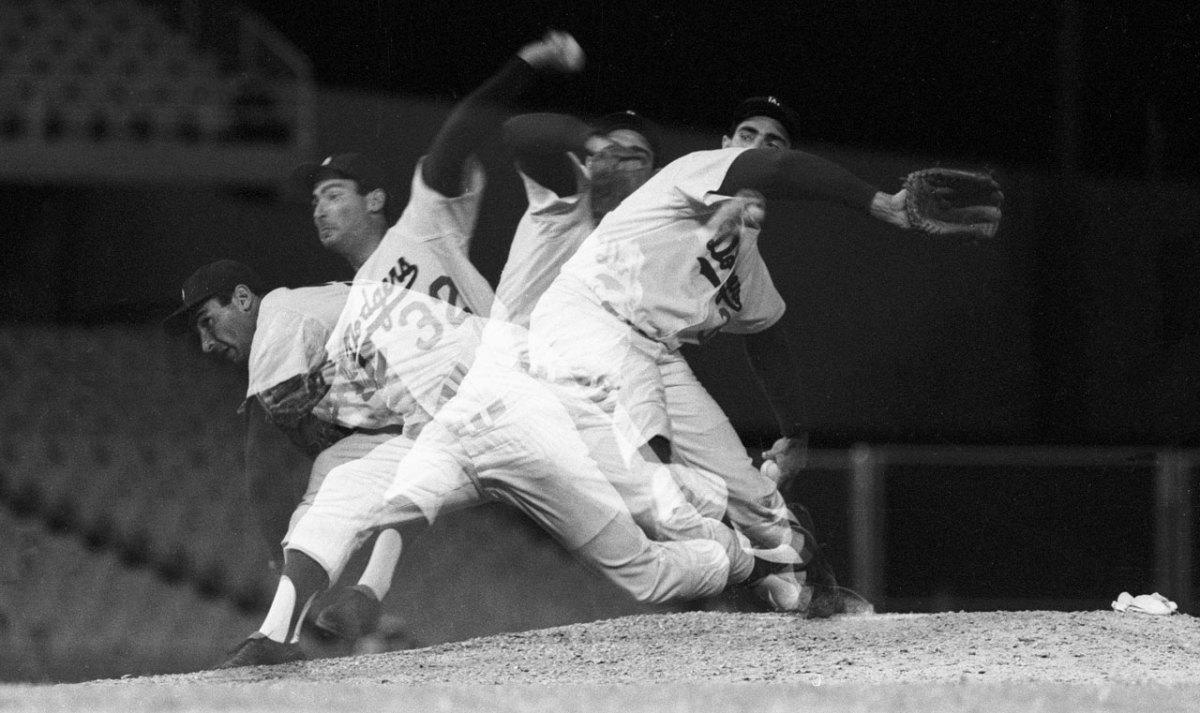
June 30, 1962
Sandy Koufax with Gene Kelly and his wife Jeanne Coyne

June 30, 1962
Sandy Koufax
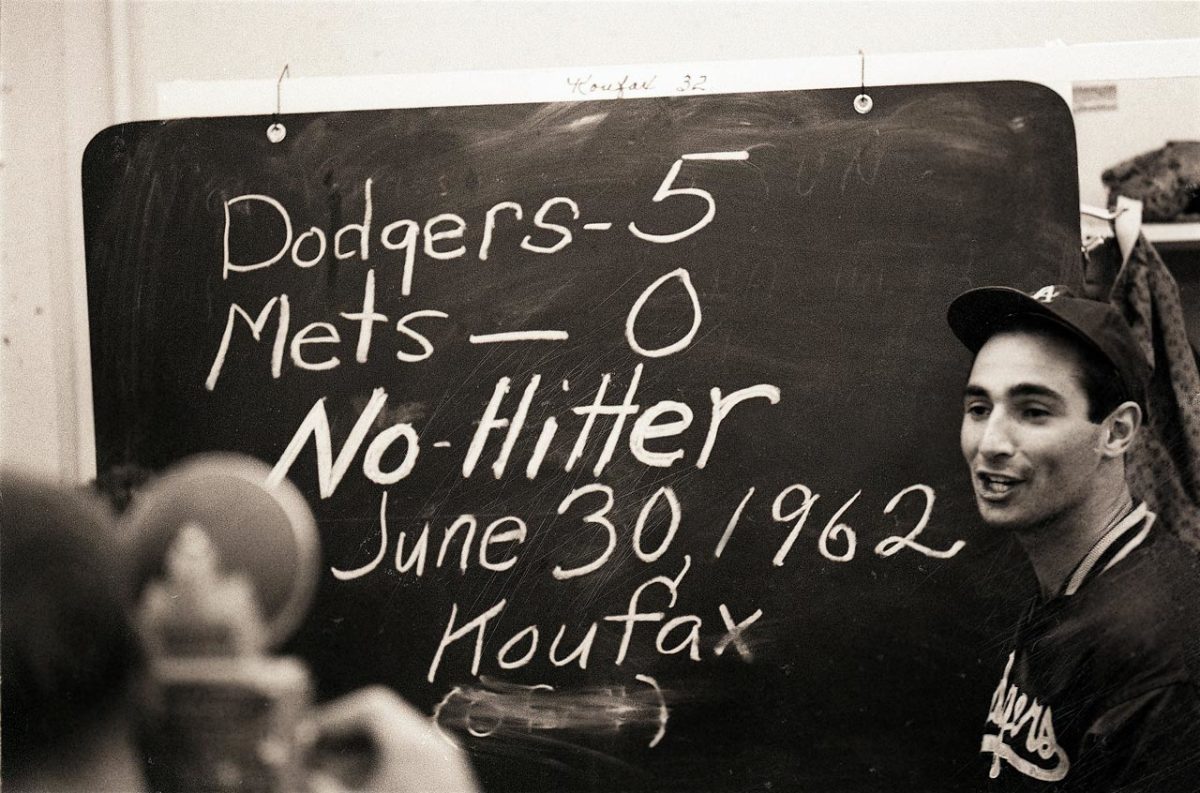
June 30, 1962
Sandy Koufax
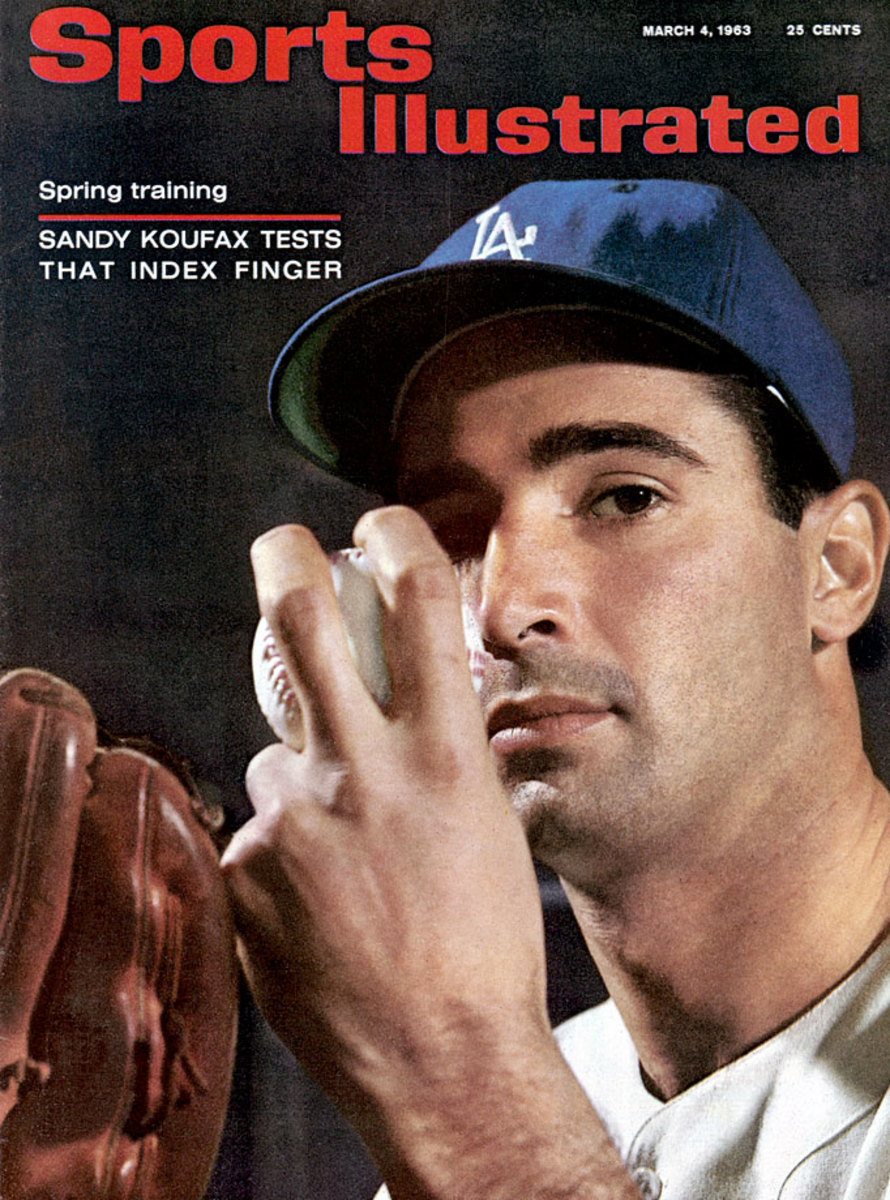
March 4, 1963 SI cover
Jim Gilliam, Sandy Koufax, Leo Durocher and Johnny Podres
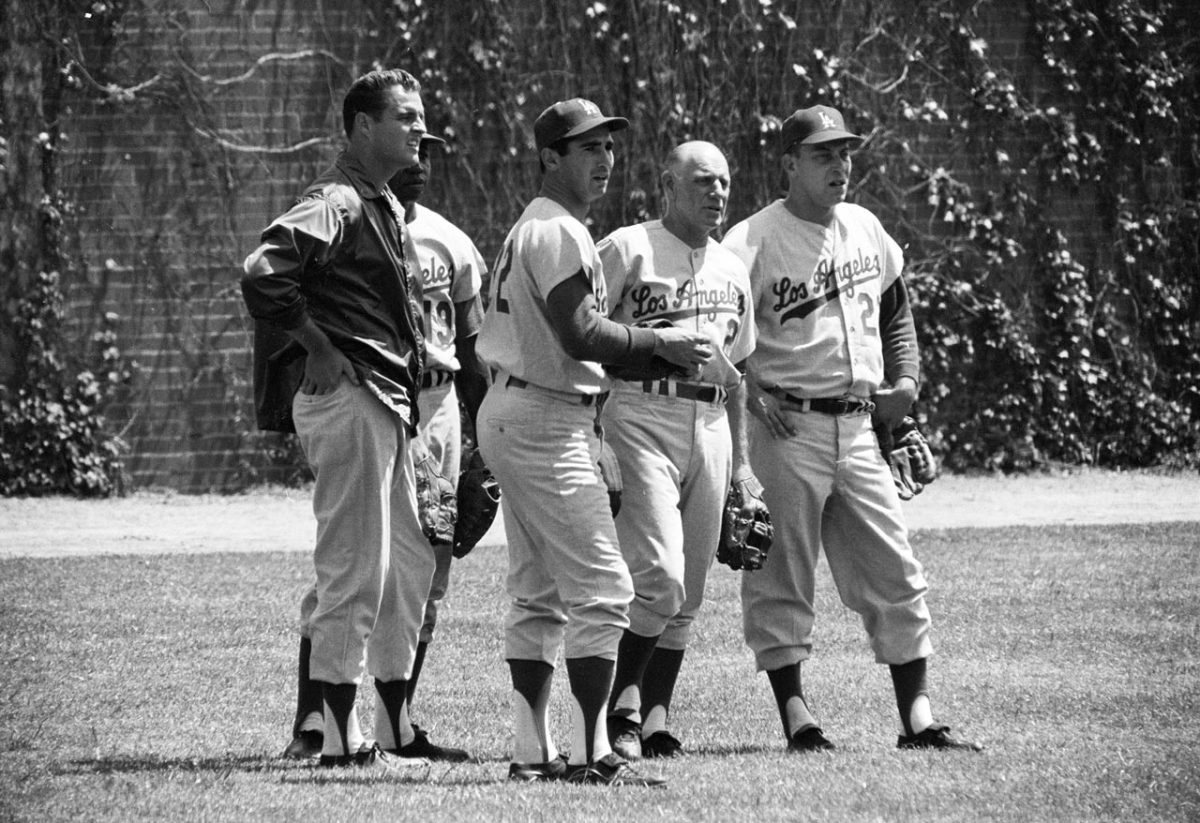
May 4, 1963
Sandy Koufax
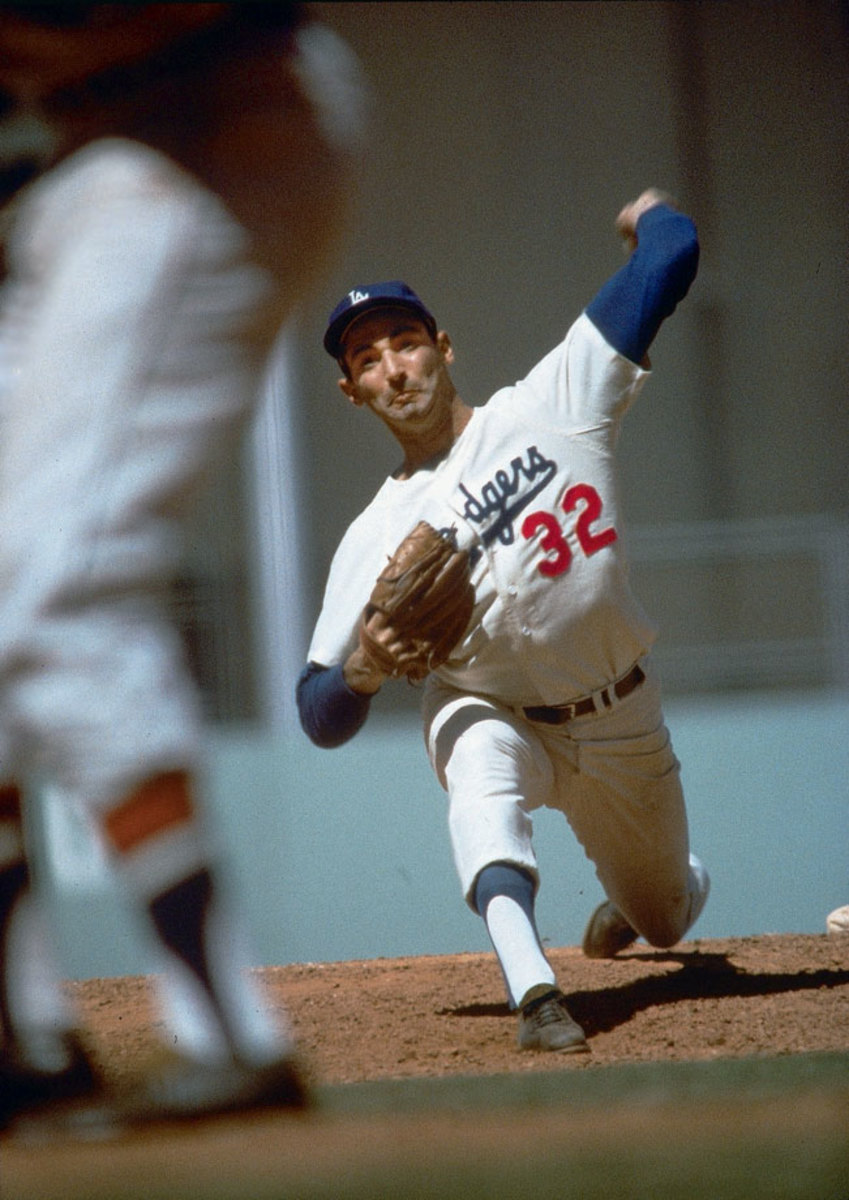
Aug. 25, 1963
Sandy Koufax

Aug. 25, 1963
Sandy Koufax

Aug. 25, 1963
Sandy Koufax

Sept. 2, 1963
Sandy Koufax
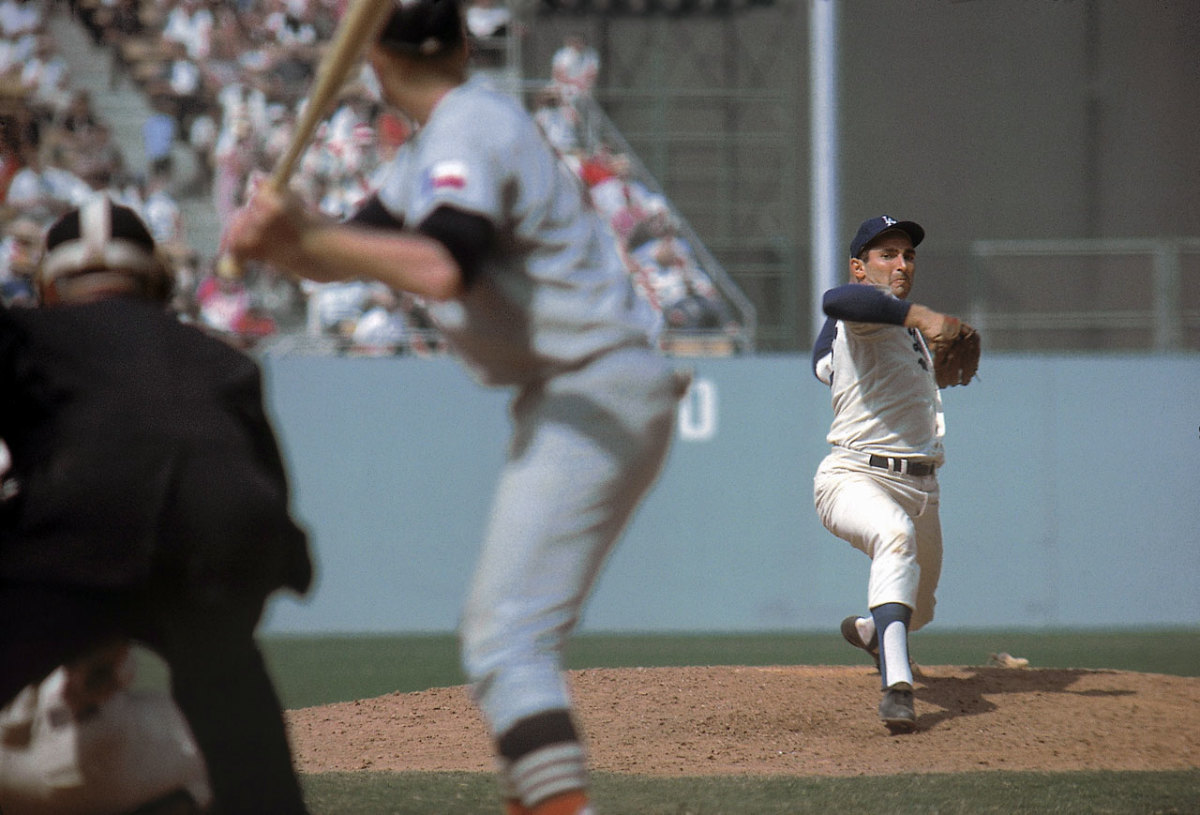
Sept. 2, 1963
Sandy Koufax
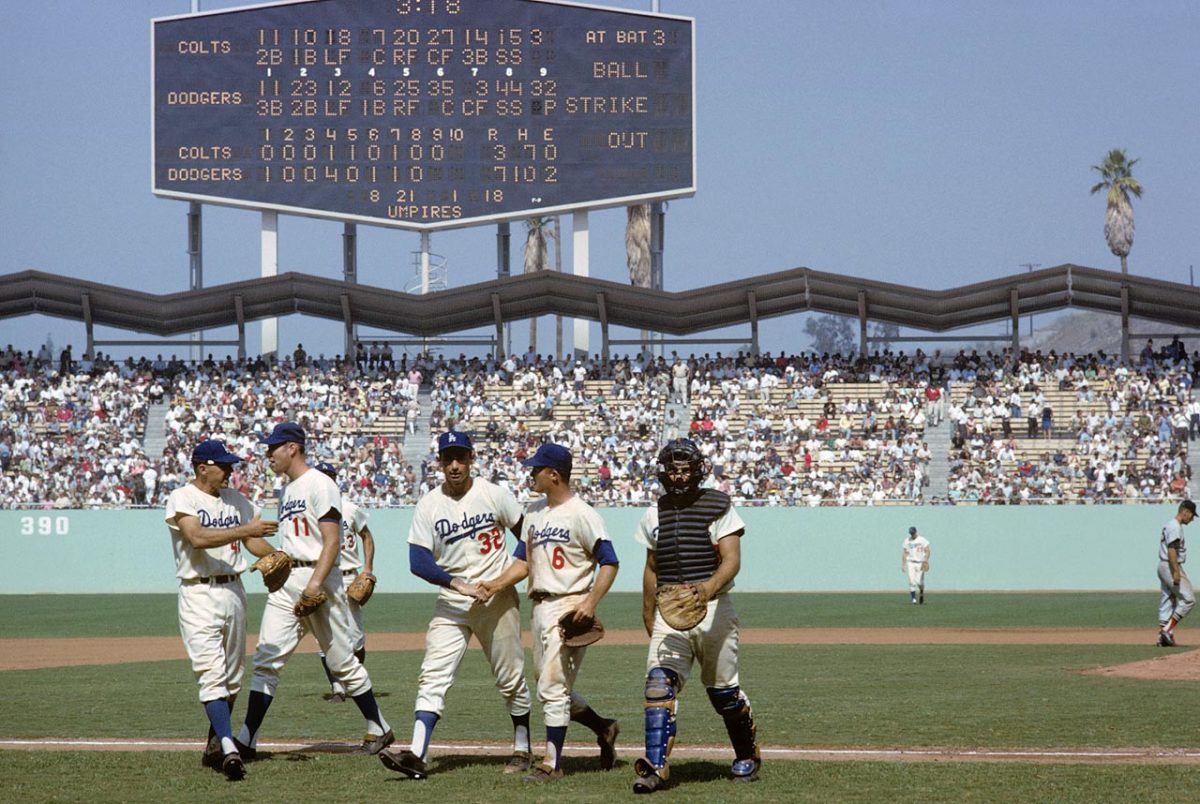
Sept. 2, 1963
Sandy Koufax and Stan Musial
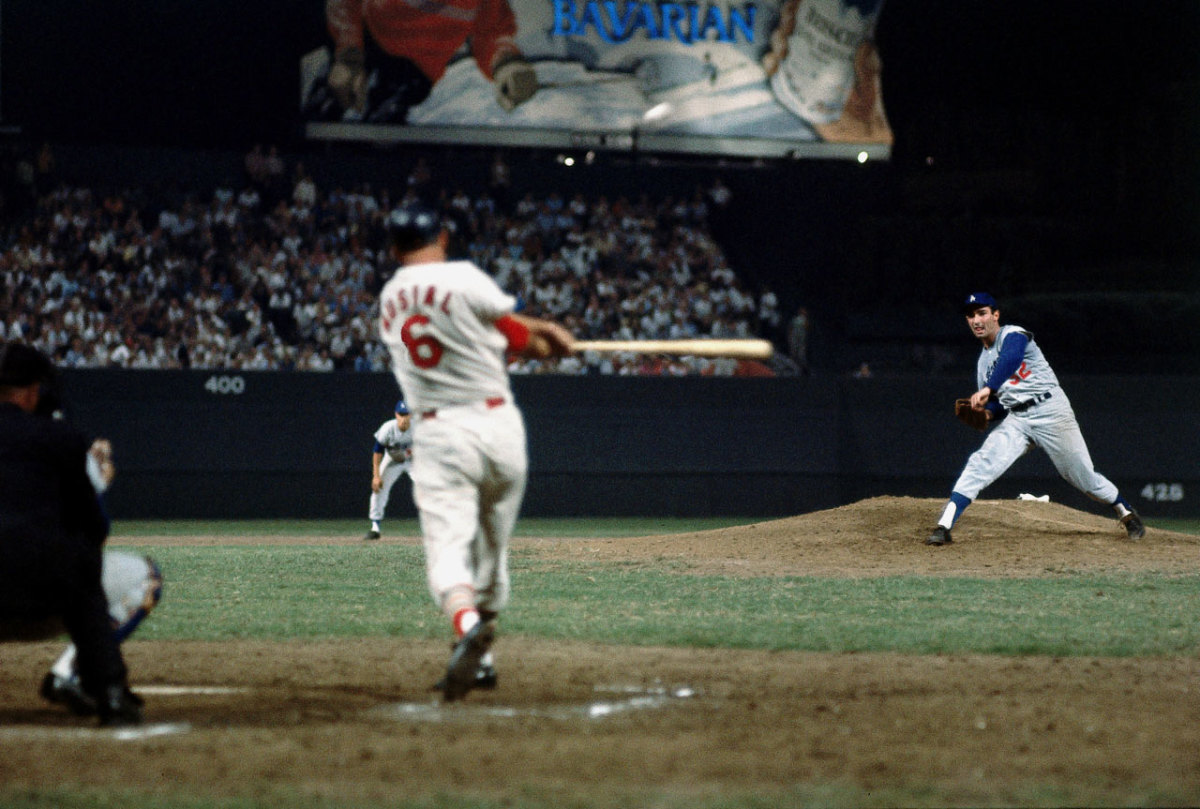
Sept. 17, 1963
Sandy Koufax
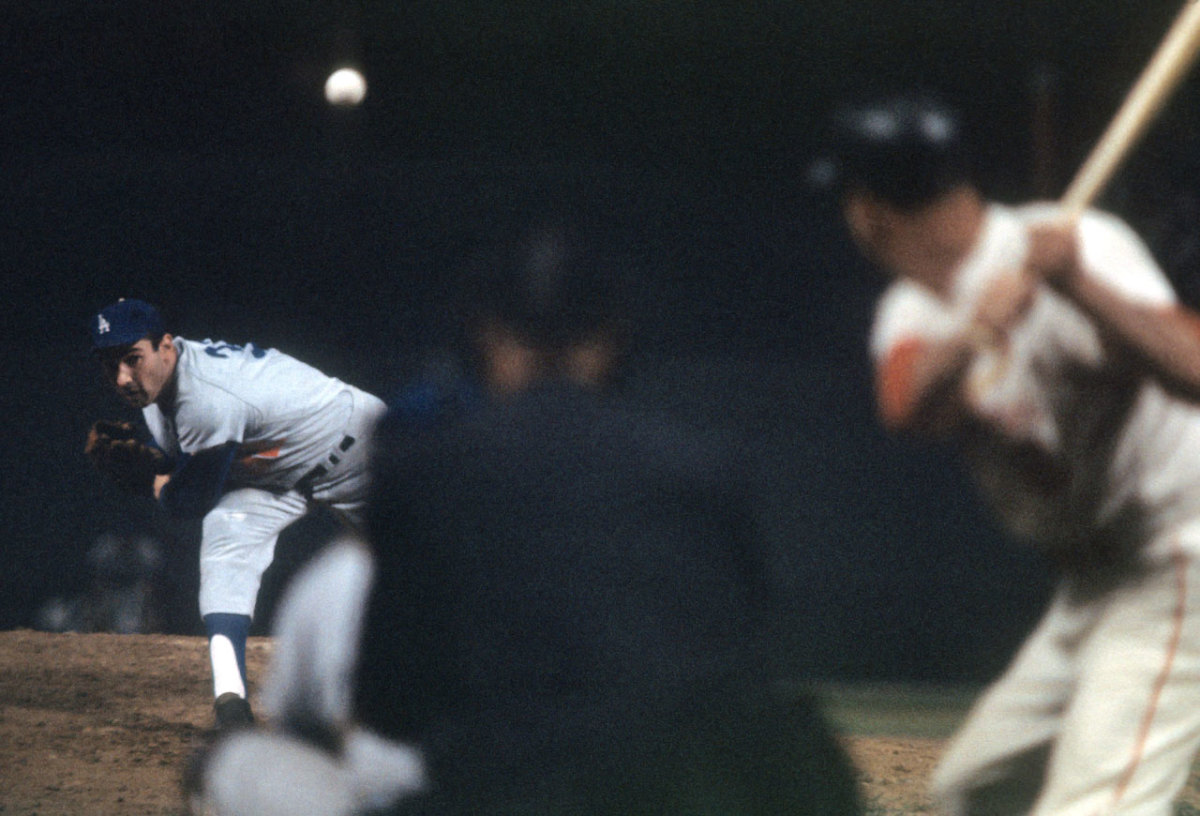
Sept. 17, 1963
Sandy Koufax and Tim McCarver

Sept. 17, 1963
Sandy Koufax

Sept. 17, 1963
Sandy Koufax

1963 World Series Game 1
Sandy Koufax
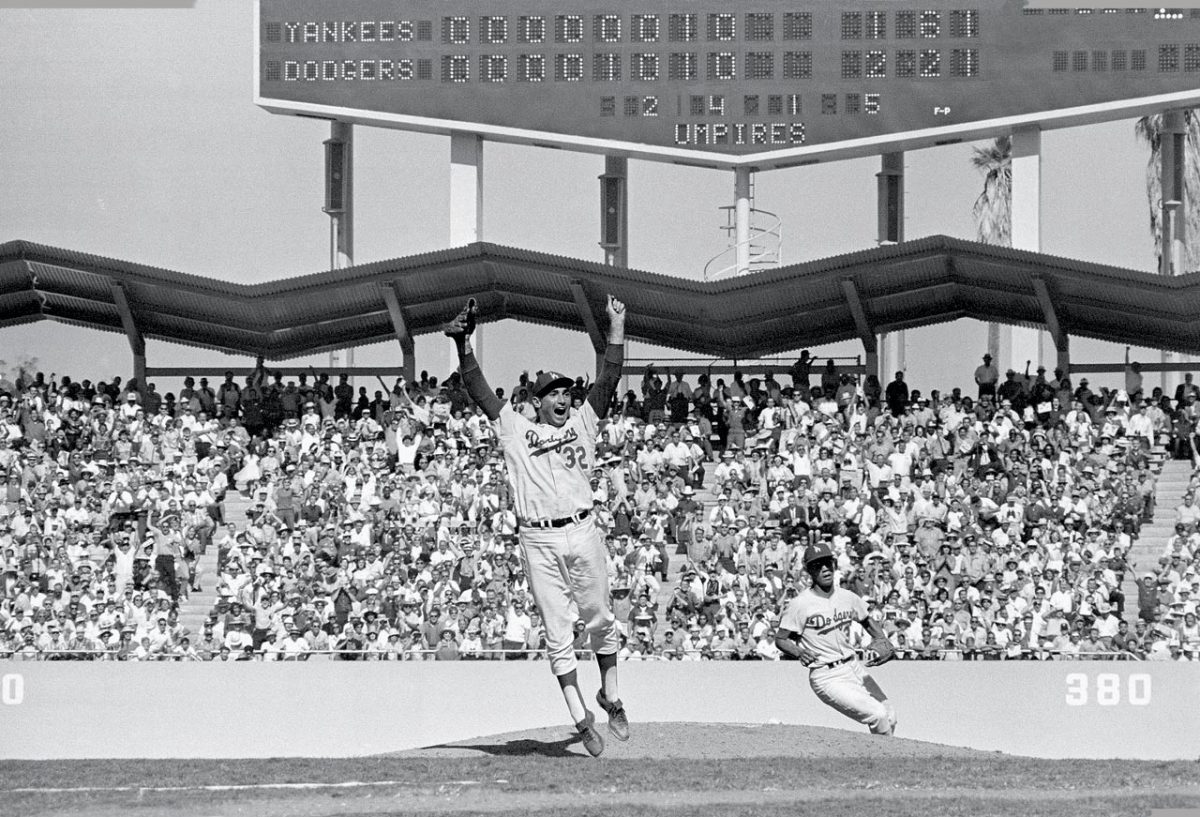
1963 World Series Game 4
Sandy Koufax and John Roseboro
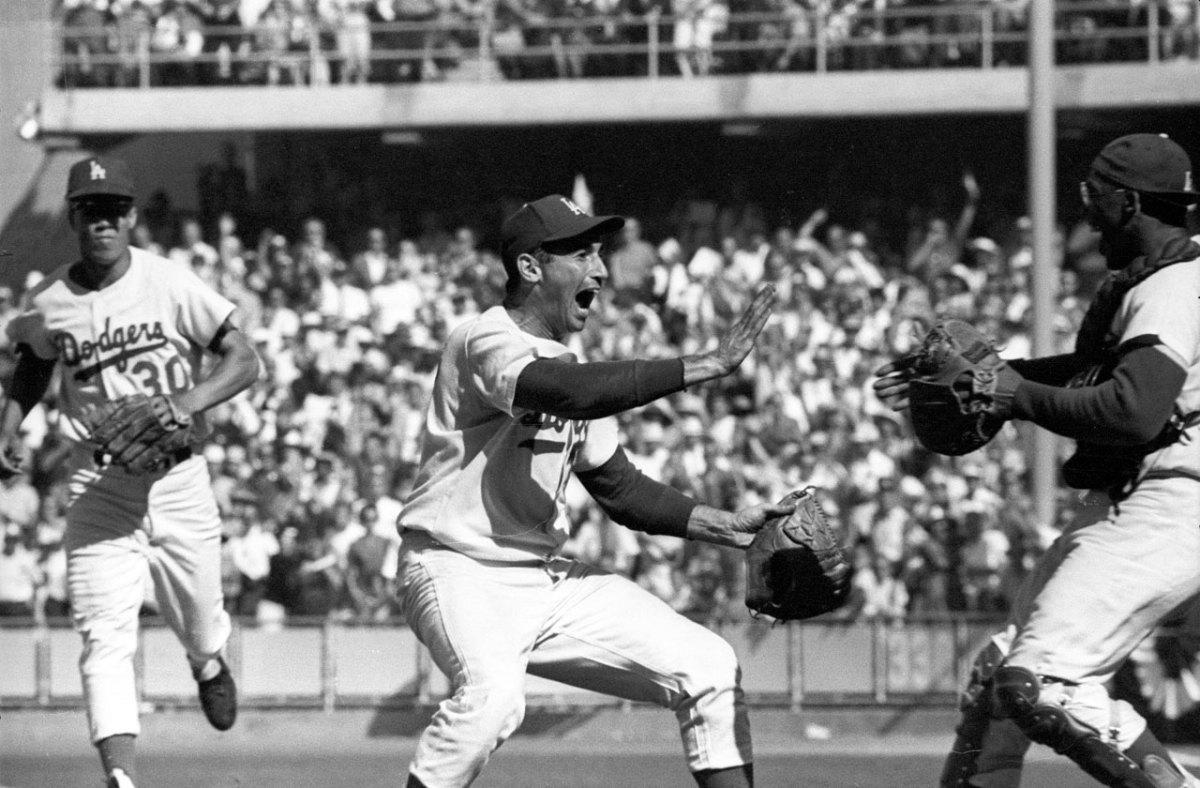
1963 World Series Game 4
Sandy Koufax
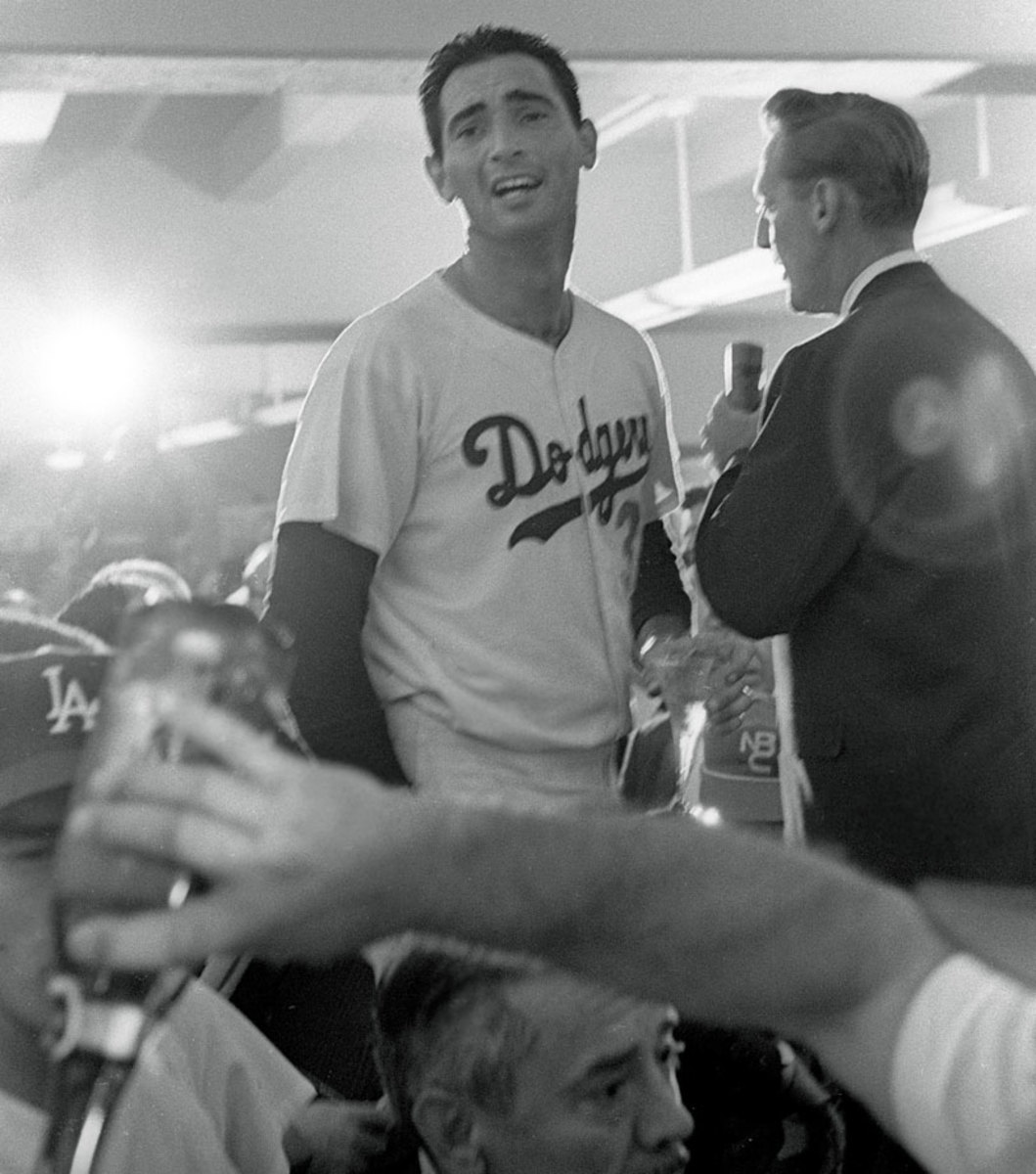
1963 World Series Game 4
Sandy Koufax
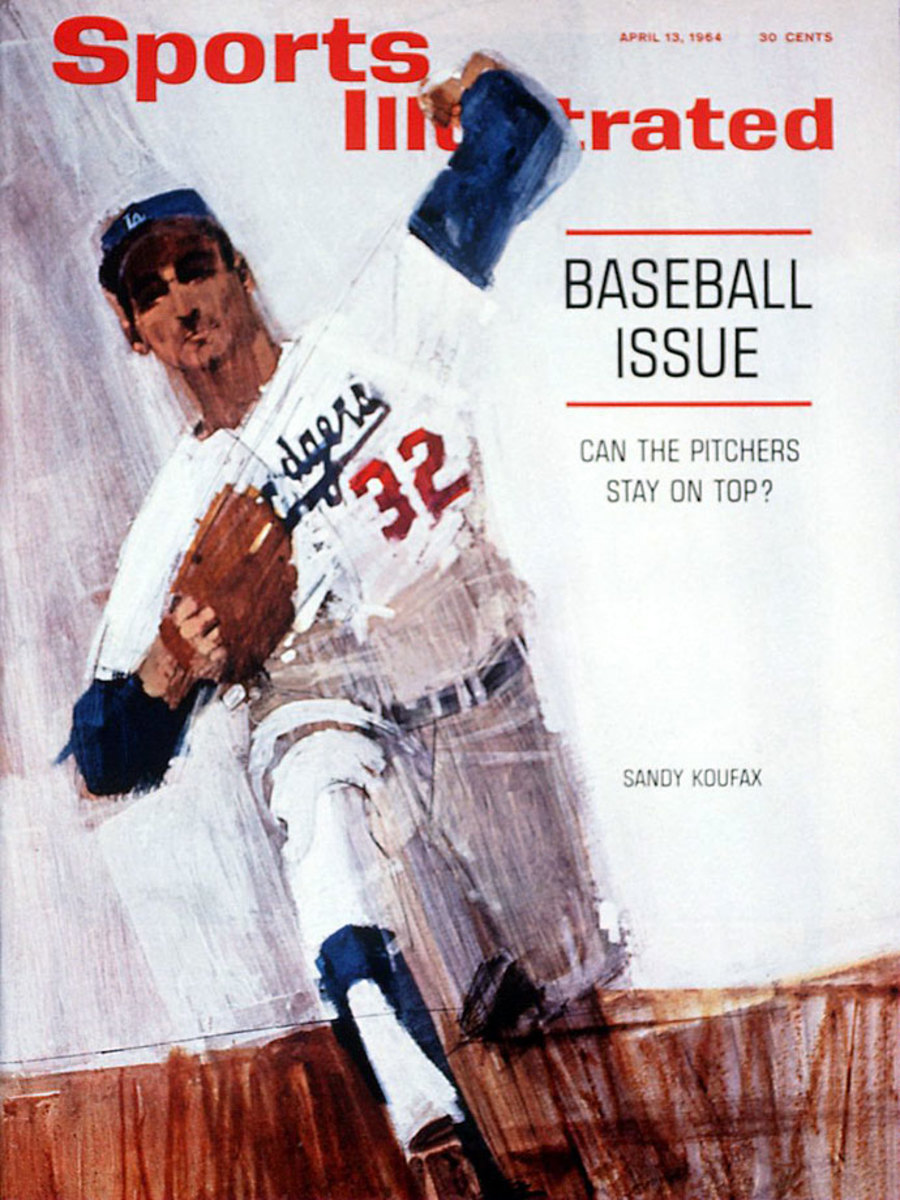
April 13, 1964 SI cover
Sandy Koufax

June 12, 1965
Sandy Koufax

Aug. 22, 1965
Sandy Koufax

1965 World Series
Sandy Koufax

July 9, 1966
Sandy Koufax

July 12, 1999 SI cover
Sandy Koufax and Joe Torre
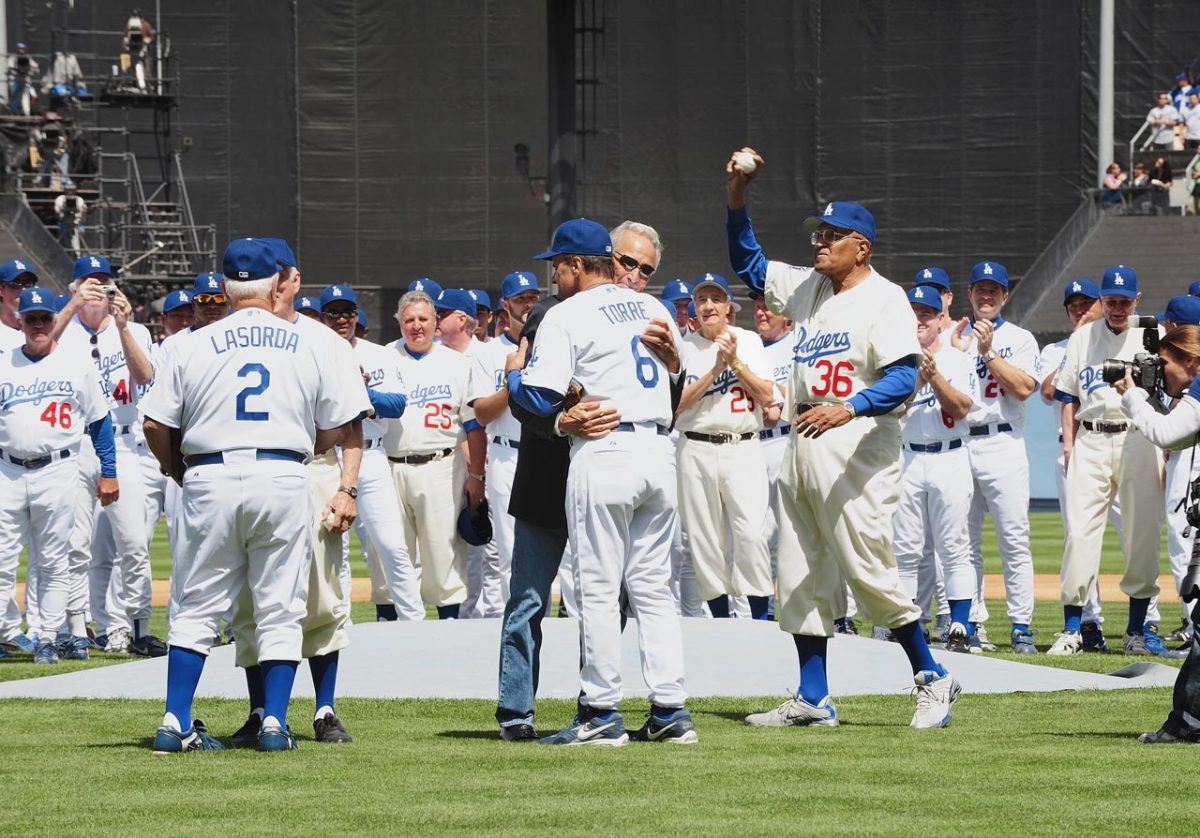
March 31, 2008
Sandy Koufax

April 1, 2013
Sandy Koufax
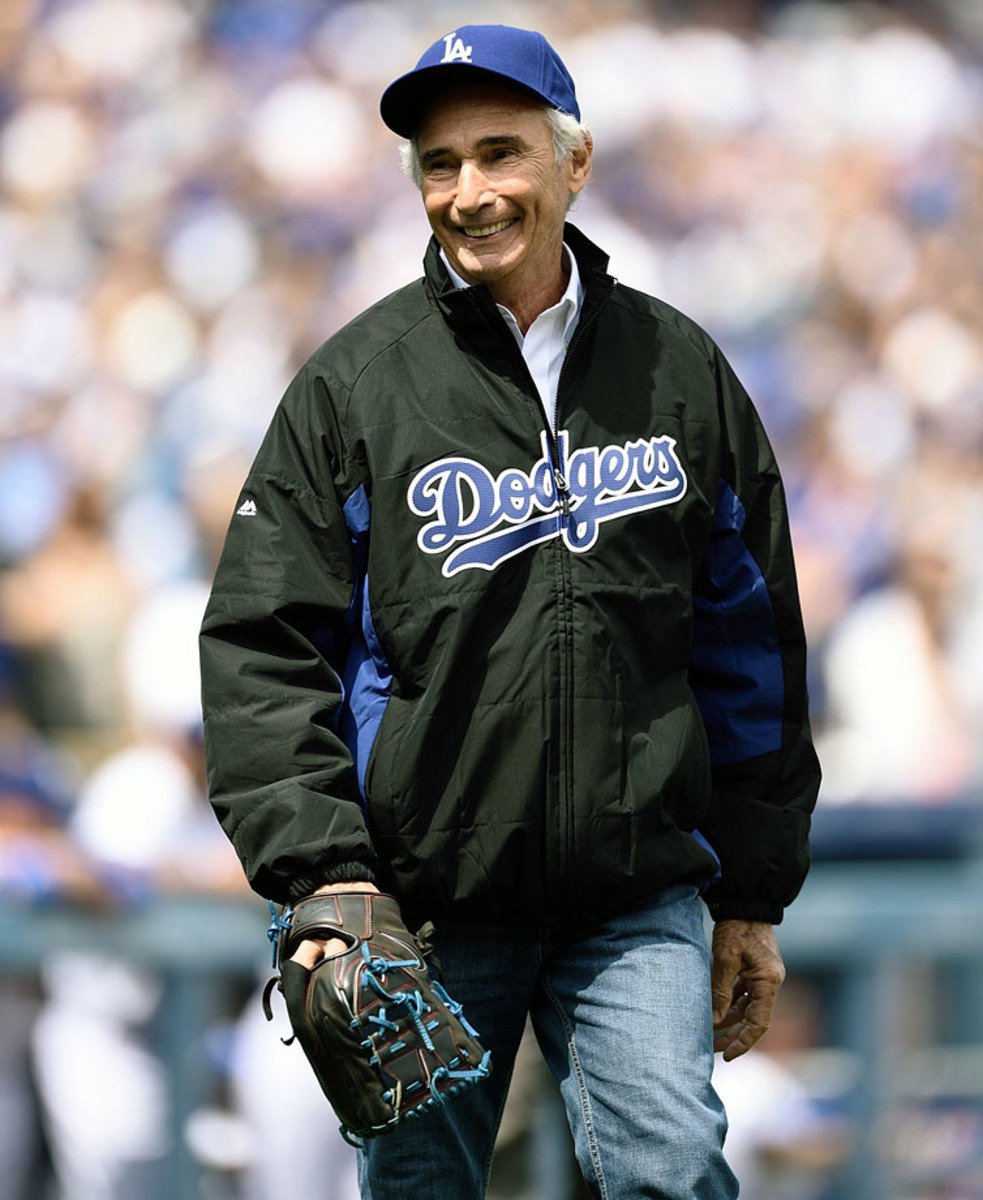
April 4, 2014
